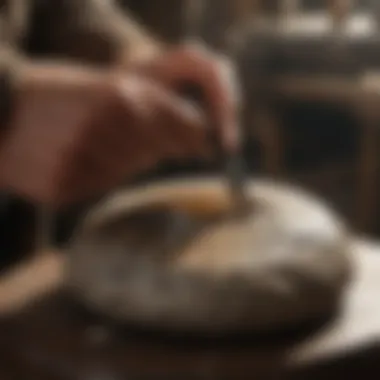Expert Guide: Mastering the Art of Polishing Stones with a Dremel Tool


Rock and Fossil Identification
When delving into the world of stone polishing with a Dremel tool, it becomes imperative to first understand the essence of rock and fossil identification. Different types of rocks and fossils exhibit unique characteristics that are essential to discern for optimal polishing results. For enthusiasts looking to elevate their collections, familiarizing oneself with the diverse types and characteristics of rocks and fossils is a fundamental stepping stone. Having the right tools for identification further streamlines the process, ensuring accuracy and precision in selecting the ideal specimens for polishing.
Techniques for Crafting Masterpieces
Crafting exquisite stone creations through the art of polishing with a Dremel tool is a meticulous process that involves mastering various techniques. From selecting the most suitable polishing attachments to honing the perfect angle and pressure, every detail plays a crucial role in achieving stunning results. Understanding the intricacies of temperature control during the polishing process is key to preventing damage and ensuring a flawless finish. Aspiring artisans in the realm of stone polishing must approach each piece with patience and precision, embracing the nuanced artistry that culminates in masterpieces.
Tips for Unveiling Geological Wonders
Unlocking the beauty of geological wonders requires a delicate balance of skill and knowledge. Identifying prime collecting sites rich in unique rock formations and fossils is the initial step towards unearthing hidden treasures. Implementing best practices for safe extraction ensures the preservation of specimens and maintains the integrity of geological wonders for future generations. Whether navigating rocky terrains or delicate fossil beds, employing proper techniques and equipment is paramount in safeguarding these natural marvels.
Enhancing Display Aesthetics
Preserving and showcasing polished stones and fossils is an art form in itself, requiring careful consideration of preservation techniques and display methods. Implementing preservation techniques such as sealing or framing enhances the longevity and visual appeal of polished specimens. Optimal storage methods prevent degradation and maintain the vibrancy of rock and fossil collections over time. Embracing creative display ideas, whether through thematic arrangements or innovative mounting solutions, adds a touch of artistry to showcasing geological marvels.
Insight into Geological Marvels
Exploring the depths of geological formations unveils a tapestry of scientific wonders and historical significance. Delving into the geological processes that sculpted landscapes and formed minerals offers profound insights into the Earth's transformative history. Recognizing the historical significance of rocks and fossils sheds light on past environments and evolutionary trajectories. From notable discoveries that reshape our understanding of the Earth's past to ongoing geological research that uncovers new insights, the realm of geological insights is a vast and intriguing landscape ready for exploration.
Preamble
Imagine the allure of transforming dull, rough stones into glistening gems; an art form that marries precision and creativity. The process of polishing stones with a Dremel tool is not merely a craft; it is a journey of elevating geological treasures to breathtaking new levels. This article serves as a guiding beacon for enthusiasts, unveiling the meticulous techniques and essential insights necessary to achieve remarkable results in the world of rock and fossil collection. Through detailed explanations and expert tips, readers will be empowered to embark on a transformative experience where each stone becomes a canvas for artistic expression and appreciation of the Earth's natural beauty.
Understanding the Importance of Polishing
Enhancing Aesthetics
In the realm of stone polishing, enhancing aesthetics is a paramount consideration. The ability to bring out the innate beauty of a rock, highlighting its unique colors, patterns, and textures, is a transformative process. By honing in on these aesthetic qualities, enthusiasts can create visually striking pieces that serve as both showcases of nature's artistry and personal expressions of creativity. The meticulous nature of enhancing aesthetics ensures that each polished stone tells a story, captivating observers with its mesmerizing allure. This aspect of polishing not only adds value to the specimens but also fosters a deep appreciation for the geological wonders that adorn our planet.
Preserving Specimens
Preserving specimens serves as a dual-purpose in the realm of stone polishing. Beyond the cosmetic aspect, maintaining the integrity of the stone ensures that its geological significance remains intact. By carefully polishing and preserving specimens, enthusiasts can honor the geological history encapsulated within each rock or fossil. This meticulous process not only safeguards the physical structure of the specimen but also safeguards its scientific value, allowing future generations to marvel at the intricate details preserved through skilled polishing techniques. The art of preserving specimens is a blend of artistry and conservation, ensuring that the legacy of these geological marvels endures through time.


Tools and Materials
Dremel Rotary Tool
Central to the art of stone polishing is the Dremel rotary tool, a versatile instrument that serves as a craftsman's trusted companion. With its precision control and array of attachments, the Dremel rotary tool empowers enthusiasts to sculpt and refine stones with unparalleled accuracy. This tool stands out for its ergonomic design, making it a preferred choice for both novice hobbyists and seasoned artisans. The Dremel rotary tool's exceptional versatility allows users to adapt their polishing techniques to suit various stone types, ensuring a tailored approach to each polishing project.
Various Polishing Bits
When it comes to stone polishing, the selection of polishing bits is a critical consideration. The range of various polishing bits offers enthusiasts a diverse toolkit to address different shaping and polishing needs. From coarse grits for initial shaping to fine abrasive bits for achieving a high-gloss finish, each polishing bit plays a distinct role in the refinement process. The versatility of various polishing bits allows users to experiment with different textures and finishes, exploring creative avenues in stone polishing. This variety ensures that every polishing project is infused with a unique touch, resulting in customized and stunning outcomes.
Protective Gear
While engrossed in the art of stone polishing, safeguarding one's well-being is of utmost importance. Protective gear serves as a vital component of the polishing process, shielding enthusiasts from potential hazards. From eye protection to respiratory masks, each piece of protective gear plays a crucial role in ensuring a safe and comfortable polishing experience. The inclusion of protective gear not only promotes safe working practices but also instills confidence in enthusiasts, allowing them to focus on the artistry of stone polishing without unnecessary concerns. Prioritizing protective gear is a testament to conscientious craftsmanship and a commitment to both personal safety and enjoyment of the polishing process.
Setting Up Your Workspace
Ventilation
Effective ventilation is a cornerstone of a well-prepared stone polishing workspace. Adequate ventilation ensures the removal of dust particles and abrasive residues, creating a clean and safe environment for polishing endeavors. Proper airflow helps disperse potentially harmful fumes and contaminants, promoting a healthier working atmosphere for enthusiasts. By prioritizing ventilation in the workspace, individuals can embark on their polishing journey with peace of mind, knowing that their health and surroundings are safeguarded throughout the process.
Safety Precautions
In the realm of stone polishing, safety precautions are non-negotiable. These measures serve as protective barriers, mitigating risks and ensuring a secure working environment. From wearing protective gear to following operational guidelines, embracing safety precautions is paramount in safeguarding against accidents or injuries. By adhering to established safety protocols, enthusiasts can engage in stone polishing activities with confidence, focusing on the creative aspects of the craft without compromising on personal well-being. Safety precautions not only promote a secure workspace but also nurture a culture of responsible and mindful craftsmanship, elevating the stone polishing experience to new horizons.
Choosing the Right Stones
In the realm of stone polishing with a Dremel tool, the paramount task at hand is selecting the optimal stones that align with your artistic vision and technical requirements. This pivotal stage sets the foundation for the entire polishing process, dictating the outcome's quality and visual appeal. The choice of stones holds immense significance in this article as it is the bedrock upon which the art of stone polishing stands. By meticulously delving into the qualities, characteristics, and inherent properties of different stones, enthusiasts can unlock the full potential of their creations.
Types of Stones Suitable for Polishing
Hardness and Composition
A fundamental aspect that directly influences the polishing outcome is the hardness and composition of the stones chosen for the task. Hardness plays a critical role in determining how effectively a stone can be shaped and polished. Stones with ideal hardness levels offer a smooth and consistent polishing experience, ensuring the final product achieves a lustrous finish. The composition of the stone also affects the polishing process, with certain compositions responding better to polishing techniques than others. Understanding the nuances of hardness and composition empowers enthusiasts to make informed decisions when selecting stones for their projects. Utilizing stones with the right balance of hardness and composition enhances the efficiency of the polishing process, resulting in exquisite final creations that exude beauty and craftsmanship.


Inspecting and Preparing Stones
Cleaning
A crucial step in the stone polishing journey is thorough cleaning of the chosen specimens. Effective cleaning ensures the removal of dirt, debris, and other impurities that may hinder the polishing process. Clean stones not only facilitate seamless polishing but also contribute to the overall visual appeal of the final product. Prioritizing cleaning as part of the preparation process sets a strong foundation for successful stone polishing endeavors.
Removing Imperfections
The quest for the perfect polished stone entails meticulous attention to detail, including the removal of imperfections. Imperfections such as cracks, blemishes, or irregular surfaces can detract from the final polish's beauty. By addressing these imperfections proactively, enthusiasts pave the way for a refined and flawless polishing experience. The process of removing imperfections elevates the overall quality of the final product, ensuring a stunning end result that showcases the natural beauty of the stone.
Polishing Techniques
When delving into the intricate process of polishing stones with a Dremel tool, the spotlight naturally falls on the importance of mastering various polishing techniques. The art of polishing is not merely about enhancing the aesthetics of rocks and fossil specimens; it's a meticulous craft that requires precision and dedication. Polishing techniques play a fundamental role in the final outcome of your project, dictating the level of shine and smoothness achieved on the surface of the stone. By understanding and implementing these techniques effectively, rock and fossil enthusiasts can elevate their collections to new heights, showcasing the beauty and intricacies of geology.
Grinding and Shaping
Rough Shaping
Rough shaping holds a pivotal position in the journey of polishing stones with a Dremel. This initial phase involves the removal of excess material from the stone, laying the groundwork for the finer shaping processes to follow. The key characteristic of rough shaping lies in its ability to quickly transform a rough, unrefined stone into a more defined shape, paving the way for intricate detailing. Despite its rather aggressive nature, rough shaping is a necessary step in achieving precise results with your Dremel tool. While it may seem rough around the edges, the advantages of this process are unmistakable, setting the stage for a refined final product.
Fine Shaping
Fine shaping, the subsequent phase of the shaping process, takes the rough-hewn stone to a new level of refinement. This stage focuses on smoothing out the surface of the stone, refining its contours, and preparing it for the polishing phase. The key characteristic of fine shaping lies in its attention to detail and precision, ensuring that every curve and angle of the stone is optimized for a flawless finish. While more meticulous and time-consuming than rough shaping, this process is indispensable for achieving a polished stone that exudes elegance and craftsmanship. Fine shaping may require patience, but the benefits of its contribution to the overall polishing process are undeniable.
Polishing Process
Step-by-Step Guide
The polishing process represents the heart of stone polishing with a Dremel tool, where the magic of transforming raw stones into gleaming gems takes place. The step-by-step guide provides a clear roadmap for navigating the intricacies of polishing, from selecting the right polishing compound to applying the perfect amount of pressure. The key characteristic of the step-by-step guide is its structured approach, breaking down the polishing process into manageable steps that ensure consistent results. By following each step meticulously, enthusiasts can gradually unveil the hidden beauty within their stones, gradually revealing a lustrous finish that captures the essence of their geological treasures.
Buffing and Final Touches
Achieving a Glossy Finish


As the final stage in the stone polishing journey, achieving a glossy finish is the crowning achievement that encapsulates the essence of polished stones. This phase involves buffing the stone to a brilliant shine, smoothing out any remaining imperfections, and enhancing the vibrancy of its colors. The key characteristic of achieving a glossy finish is its transformative power, turning a modest stone into a radiant masterpiece. While the process demands attention to detail and a gentle touch, the results speak for themselves, with stones radiating a mesmerizing glow that reflects the dedication and skill invested in the polishing process. With patience and precision, enthusiasts can master the art of achieving a glossy finish, embellishing their collections with stones that captivate and impress.
Troubleshooting and Tips
When delving into the art of polishing stones with a Dremel, insightful comprehension of troubleshooting and tips becomes paramount. This section serves as a guiding light, shedding light on the critical aspects, benefits, and considerations regarding polishing intricacies. By immersing in this discourse, enthusiasts will glean essential knowledge precipitating substantial enhancements to their craft.
Common Issues
Overheating
Within the scope of stone polishing, overheating holds a pivotal role. Its significance reverberates through the entire polishing process, dictating outcomes profoundly. The unique characteristic of overheating lies in its ability to expedite the polishing stages, albeit with potential drawbacks. Overheating crafts a fine balance between efficiency and risk, making it a prevalent choice for adept practitioners seeking swift results. Adversely, overheating may jeopardize stone integrity, thus exemplifying its dual nature in this context.
Uneven Polishing
Amidst the realm of stone polishing nuances, uneven polishing stands as a noteworthy challenge. Its impact on the overarching goal of achieving impeccable shine and flawless surfaces is colossal. The distinctive trait of uneven polishing underscores its prevalence in polishing narratives, showcasing the necessity for meticulous attention to detail. Its allure lies in presenting a canvas upon which mastery can shine but also conceals pitfalls for the unprepared. Recognizing the dichotomy of its nature proves vital in navigating the polishing landscape effectively.
Pro Tips for Optimal Results
Pace Yourself
Embarking on a stone polishing expedition demands paced introspection. 'Pacing yourself' encapsulates the essence of measured progress, advocating for a balanced approach amidst the whirlwind of creativity. The salient feature of pacing yourself reveals why it stands as a beacon in this domain, urging practitioners to tread carefully and embrace gradual evolution. The unique draw of this principle lies in its ability to nurture skill development while sidestepping burnout risks that often plague enthusiasts. Discerning the advantages and disadvantages embedded in this gem of wisdom unearths pathways to sustained growth and proficiency.
Experimenting with Techniques
Venturing into uncharted territories within the realm of stone polishing beckons experimentation with techniques. This facet enriches the holistic understanding of the craft, paving the way for innovation and refinement. The defining trait of experimenting with techniques manifests in cultivating a dynamic landscape of possibilities, aligning with the ethos of exploration. Its appeal stems from the freedom to diverge from conventional norms, albeit not without potential drawbacks. Embracing the spirit of experimentation unveils avenues for honing skills and unlocking latent potential within the stone polishing milieu.
Final Thoughts
Finalizing the intricate process of stone polishing warrants a moment of reflection and appreciation. The essence of 'Final Thoughts' in this guide lies in acknowledging the culmination of efforts exerted in each polished stone piece. It serves as a holistic view of the journey embarked upon, from selecting the right stones to mastering the art of polishing with a Dremel tool. By embracing the imperfections encountered along the way, artisans elevate their craft to a realm where uniqueness reigns supreme. Artistry intertwined with science forms the backbone of this endeavor, culminating in a display of resplendent geological beauty.
Appreciating the Craft
Embracing Imperfections
The ethos of 'Embracing Imperfections' reverberates through the core of stone polishing with a Dremel, emphasizing the beauty found within imperfection. In this guide, imperfections are not flaws but rather facets of geological history embedded within each stone. The allure of embracing imperfections rests in honoring the natural vagaries of rock formations, underscoring the authenticity of the final polished piece. This approach champions individuality over uniformity, allowing artisans to wield unique narratives sculpted by nature's hand. Embracing imperfections nurtures a deep appreciation for the raw essence of stones, transcending mere aesthetics to unveil the innate character etched in every polished surface.
Showcasing Your Work
The crux of 'Showcasing Your Work' lies in the art of presentation, transforming polished stones into visual stories that captivate the beholder. Each showcased piece serves as a testament to the artisan's skill and dedication, inviting viewers to partake in the geological journey encapsulated within. Through adept presentation, artisans can communicate the narrative behind each polished stone, enriching the viewer's experience with contextual insights. Showcasing work not only commemorates the labor invested but also breathes life into inert stones, infusing them with a tale waiting to be unraveled. This practice elevates stone polishing from a mere craft to a form of storytelling, where each showcase becomes a chapter in the saga of Earth's geological treasures.







